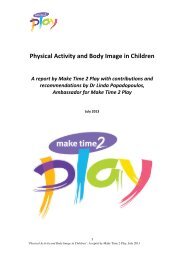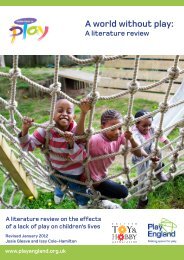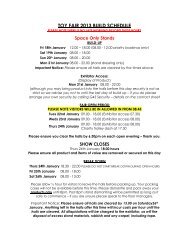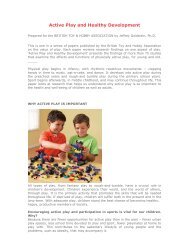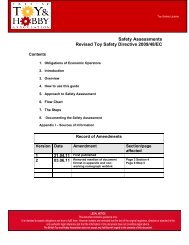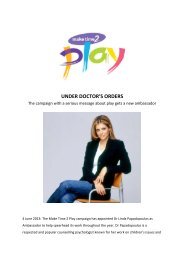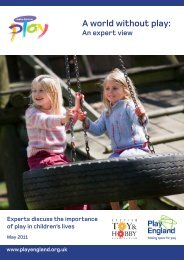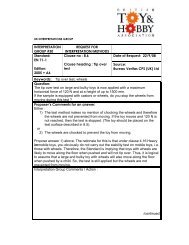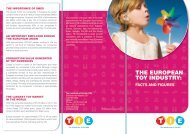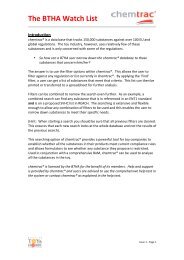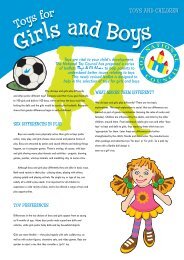Toys and Play for children who are blind or partially sighted ... - RNIB
Toys and Play for children who are blind or partially sighted ... - RNIB
Toys and Play for children who are blind or partially sighted ... - RNIB
Create successful ePaper yourself
Turn your PDF publications into a flip-book with our unique Google optimized e-Paper software.
This is part of a series of BTHA funded educational literature aimed atimproving the lives of <strong>children</strong> with special needs. This leaflet has beenprep<strong>are</strong>d in association with Godfrey Hall MA. Dip. Ed. F.Coll. P. <strong>and</strong> theRoyal National Institute of Blind People (<strong>RNIB</strong>).<strong>Toys</strong> & <strong>Play</strong> <strong>f<strong>or</strong></strong> <strong>children</strong> <strong>who</strong> <strong>are</strong>Blind <strong>or</strong><strong>partially</strong> <strong>sighted</strong>Royal National Institute of BlindPeople (<strong>RNIB</strong>) estimates thatthere <strong>are</strong> around 25,000 <strong>children</strong>in Britain under the age of 16 <strong>who</strong>sesevere sight problems affect theireducation.The term ‘visual impairment’ refers to<strong>children</strong> <strong>who</strong> <strong>are</strong> either <strong>blind</strong> <strong>or</strong> <strong>partially</strong><strong>sighted</strong>.o ‘Blind’ means a high degree of visionloss, seeing much less than is typical<strong>or</strong> perhaps nothing at all. Most <strong>blind</strong><strong>children</strong> can see something (light <strong>and</strong>dark, <strong>or</strong> movement), but not verymucho ‘Partial sight’ is a less severe loss ofvision which cannot be c<strong>or</strong>rected bywearing spectacles though they mighthelp to make vision better.Most <strong>blind</strong> <strong>or</strong> <strong>partially</strong> <strong>sighted</strong> <strong>children</strong>have their sight problem from birth. Asmall number of <strong>children</strong> lose their sightthrough illness <strong>or</strong> accident.A high prop<strong>or</strong>tion (estimated 40%) of<strong>blind</strong> <strong>and</strong> <strong>partially</strong> <strong>sighted</strong> <strong>children</strong> haveadditional needs, including learning,movement <strong>and</strong> communicationdifficulties.Choosing the righttypes of toysUsing the criteria below when selectingtoys will encourage <strong>children</strong> to developtheir skills while having fun at the sametime. Both <strong>are</strong> equally imp<strong>or</strong>tant! Thecriteria <strong>are</strong> intended to make best use ofany residual vision, <strong>and</strong> to develop othersens<strong>or</strong>y skills such as the sense of touch,which is imp<strong>or</strong>tant <strong>f<strong>or</strong></strong> <strong>children</strong> <strong>who</strong> willlearn to read in braille.Try to select a toy that:o Has good colour <strong>and</strong> tone contrastsuch as yellow edging <strong>f<strong>or</strong></strong> each holeon a blue shape s<strong>or</strong>ter to make thedifferent shapes easier to locateo Has bold <strong>and</strong> clear lettering whichis easier to see such as bold blacknumbers on a white background<strong>f<strong>or</strong></strong> a play clocko Reflects light <strong>or</strong> is flu<strong>or</strong>escent such asdiffractive paper with a t<strong>or</strong>ch to attractyour child’s attention <strong>or</strong> a pull alongtoy with flashing lightso Encourages <strong>children</strong> to use their eyesto follow an object such as wind uptoys that move slowly across a surfaceto develop a child’s tracking skillso Encourages development of h<strong>and</strong>-eyeco-<strong>or</strong>dination such as posting boxes <strong>or</strong>s<strong>and</strong> trays with pourers <strong>and</strong> scoopersso that your child is able to look <strong>and</strong>reach m<strong>or</strong>e accuratelyo Encourages good co-<strong>or</strong>dination ofh<strong>and</strong>s, using both h<strong>and</strong>s together suchas construction toys with blocks <strong>or</strong>bricks that fit together <strong>and</strong> pull apartto build up strength <strong>and</strong> dexterityo Encourages development of fine fingercontrol that your child may need ifthey read through touch e.g. toy pianos<strong>or</strong> plasticine with a variety of tools <strong>or</strong> awashing line <strong>and</strong> pegso Has an interesting texture which offerssome variety to touch which is easier todiscriminate such as an elephant with
LOOK OUT FOR THIS SYMBOL!<strong>Toys</strong> with this symbol contain small parts that couldbe swallowed <strong>and</strong> cause a choking hazard. Theyshould only be given to <strong>children</strong> over 3 years <strong>or</strong> ofa m<strong>or</strong>e advanced development.<strong>Toys</strong> & <strong>Play</strong> <strong>f<strong>or</strong></strong> <strong>children</strong> <strong>who</strong> <strong>are</strong> <strong>blind</strong> <strong>or</strong> <strong>partially</strong> <strong>sighted</strong>different textured parts: c<strong>or</strong>duroy feet,leather body, chain tail <strong>and</strong> a crinklytrunk so that your child can tell thedifference between different textures<strong>and</strong> surfaceso Has moving parts that encourage littlefingers to expl<strong>or</strong>e e.g. activity cubes <strong>or</strong>an abacuso Has discrete pieces that can bediscriminated by touch e.g. a woodenpuzzle board which has different shapedpieces with clear contrasting edgeso Has switches that <strong>are</strong> recognisableby touch as on <strong>or</strong> off, <strong>and</strong> click whenoperated so that a child knows whatthey have done e.g. toy cookers thathave knobs that click <strong>or</strong> toy vacuumcleanerso Encourages underst<strong>and</strong>ing of cause<strong>and</strong> effect e.g. rattles <strong>f<strong>or</strong></strong> h<strong>and</strong>s <strong>or</strong> feetthat encourage your child to move tomake a noise <strong>or</strong> a drum <strong>and</strong> beatero Makes a sound <strong>or</strong> other cue to anaction having occurred so that yourchild knows that they have madesomething happen, such as a w<strong>or</strong>kbench with nuts that click when youuse the screwdrivero Encourages physical play e.g. pushalong toys like prams <strong>or</strong> trolleys, <strong>and</strong>trundle trikes so that your child isconfident to move aroundo Encourages development of sense ofsmell such as smelly pens <strong>and</strong> crayons<strong>or</strong> scented water <strong>f<strong>or</strong></strong> water play so thatyour child begins to use smell as anextra cue to find things <strong>or</strong> to knowwhere they <strong>are</strong>.Creating a play environment <strong>f<strong>or</strong></strong> your child<strong>Toys</strong> <strong>and</strong> play materials <strong>are</strong>an imp<strong>or</strong>tant way of enabling<strong>children</strong> to discover a varietyof sens<strong>or</strong>y experiences.The following play tips will helpmaximise your child’s developmentwhilst making them feel safe <strong>and</strong>com<strong>f<strong>or</strong></strong>table:o Give your child plenty of time toexpl<strong>or</strong>e new things. It takes muchlonger to underst<strong>and</strong> <strong>and</strong> processhow a toy w<strong>or</strong>ks by touch than itdoes by looking at ito All <strong>children</strong> need opp<strong>or</strong>tunitiesto experience challenge, risk<strong>and</strong> excitement in a way that isappropriate <strong>f<strong>or</strong></strong> themo It is essential to watch <strong>and</strong> listen toyour child’s reactions (filming yourchild can be a useful tool <strong>f<strong>or</strong></strong> this)to w<strong>or</strong>k out what stimulates them<strong>and</strong> what they enjoyo Talk to your specialist teacher <strong>f<strong>or</strong></strong><strong>children</strong> with visual impairment*about colour, contrast, lighting <strong>and</strong>using plain backgrounds. Try to findout if your child sees better on oneside, <strong>or</strong> if objects should be presentedin a particular positiono Make sure that your child is in themost suitable position to use theirh<strong>and</strong>s <strong>and</strong> eyes to best advantage,whether seated, st<strong>and</strong>ing <strong>or</strong> lyingo Define <strong>and</strong> limit the play spacearound your child to create a “den”<strong>or</strong> secure familiar base to playo Keep toys within easy reach so thatyour child’s movements can create aneffect. This might mean suspendingtoys above a child lying down, <strong>or</strong>putting objects in a table-top tray<strong>or</strong> shallow boxo If toys roll out of reach, try to takeyour child to the toy, rather thanbringing the toy back to your child.This will develop searching <strong>and</strong>mobility skillso Use language that is simple, sh<strong>or</strong>t<strong>and</strong> descriptive <strong>and</strong> relates to whatyour child is doingo If your child has repeated behaviours,try to develop them into a m<strong>or</strong>ecreative activityo Your child needs different partners,spaces, materials <strong>and</strong> objects <strong>f<strong>or</strong></strong> play.If you build on what your child isinterested in, you will encourage themto try new things, feel confident toface future challenges <strong>and</strong> take withthem a great attitude to learning.*Contact <strong>RNIB</strong> Helpline on0303 123 9999 <strong>f<strong>or</strong></strong> the contactdetails of your local specialistteacher. F<strong>or</strong> m<strong>or</strong>e in<strong>f<strong>or</strong></strong>mation visitwww.rnib.<strong>or</strong>g.uk
<strong>Toys</strong> & <strong>Play</strong> <strong>f<strong>or</strong></strong> <strong>children</strong> <strong>who</strong> <strong>are</strong> <strong>blind</strong> <strong>or</strong> <strong>partially</strong> <strong>sighted</strong>Growing throughdifferent types of playChildren develop through play frombirth. Different types of play can helpto develop a range of skills. Blind <strong>and</strong><strong>partially</strong> <strong>sighted</strong> <strong>children</strong> may have tow<strong>or</strong>k harder to use their visual skills,which can be tiring. Also, they may bem<strong>or</strong>e reliant on their tactile <strong>and</strong> listeningskills than other <strong>children</strong> as they grow<strong>and</strong> learn.Expl<strong>or</strong>at<strong>or</strong>y play encourages the useof mot<strong>or</strong> skills, stimulates the sensesof touch, hearing <strong>and</strong> vision, <strong>and</strong>introduces cause <strong>and</strong> effect. It extends<strong>children</strong>’s interest in their environment<strong>and</strong> encourages them to make senseof the w<strong>or</strong>ld around by being curious,experimenting <strong>and</strong> making connections.Imaginary/pretend play enables<strong>children</strong> to act out roles <strong>and</strong> situationsthat <strong>are</strong> familiar <strong>and</strong> unfamiliar tothem. They can practise daily routineslike shopping <strong>and</strong> cooking <strong>and</strong> expl<strong>or</strong>efantasy ideas by dressing up. Childrenneed experience of real things be<strong>f<strong>or</strong></strong>e theyunderst<strong>and</strong> ‘toy’ versions.Constructing <strong>and</strong> creating enablesyour child to express their thoughts,ideas <strong>and</strong> feelings <strong>and</strong> to develop anunderst<strong>and</strong>ing of different objects,materials <strong>and</strong> tools. This can be througharts <strong>and</strong> crafts, movement <strong>and</strong> dance,sound <strong>and</strong> music, building things <strong>and</strong>taking them apart.Games <strong>and</strong> puzzles provide challenges<strong>and</strong> encourage problem solving. Theycan give <strong>children</strong> an opp<strong>or</strong>tunity toask questions, underst<strong>and</strong> rules set byothers, <strong>and</strong> to sh<strong>are</strong> collab<strong>or</strong>ative playwith a larger group of <strong>children</strong> <strong>f<strong>or</strong></strong>longer periods.Physical play gives <strong>children</strong>opp<strong>or</strong>tunities to develop body control<strong>and</strong> co-<strong>or</strong>dination of large movements,fine manipulative skills, spatial aw<strong>are</strong>ness<strong>and</strong> balance. Children need large <strong>and</strong>small equipment, indo<strong>or</strong>s <strong>and</strong> outdo<strong>or</strong>s,to be active <strong>and</strong> develop confidence intheir movements.Outdo<strong>or</strong> play in new mown grass,leaves, mud, water, snow <strong>or</strong> s<strong>and</strong> allcontribute to a varied sens<strong>or</strong>y experience.<strong>Play</strong> in outdo<strong>or</strong> spaces can encouragemovement <strong>and</strong> mobility, <strong>and</strong> can enablem<strong>or</strong>e boisterous physical play.“toptip”Everyday items canextend a child’s experience ofthe real w<strong>or</strong>ld through play. Make a Treasure Basketusing a sturdy, shallow basket, containing a collectionof everyday items. The items might include a bunch ofkeys, teddy bear, paper, ribbons, a whisk, a wooden eggcup<strong>or</strong> a lemon. These items will vary in weight, size, texture,colour, taste, temperature <strong>and</strong> sound. Objects should bewashable, disposable <strong>or</strong> replaceable. Children will use all oftheir senses to discover what an object is, what it islike <strong>and</strong> what it can do.Further in<strong>f<strong>or</strong></strong>mationGet toy updates in Insight magazine.Insight, <strong>RNIB</strong>’s magazine <strong>f<strong>or</strong></strong> p<strong>are</strong>nts<strong>and</strong> professionals, will have a regularsection featuring new toys <strong>f<strong>or</strong></strong> <strong>blind</strong> <strong>and</strong><strong>partially</strong> <strong>sighted</strong> <strong>children</strong>. Find out m<strong>or</strong>efrom rnib.<strong>or</strong>g.uk/insightmagazineA clear print version of this leafletis also available.



